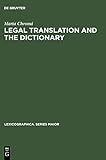Legal Translation and the Dictionary / Marta Chromá.
Material type: TextSeries: Lexicographica. Series Maior : Supplementbände zum Internationalen Jahrbuch für Lexikographie ; 122Publisher: Tübingen : Max Niemeyer Verlag, [2013]Copyright date: ©2004Edition: Reprint 2013Description: 1 online resource (122 p.)Content type:
TextSeries: Lexicographica. Series Maior : Supplementbände zum Internationalen Jahrbuch für Lexikographie ; 122Publisher: Tübingen : Max Niemeyer Verlag, [2013]Copyright date: ©2004Edition: Reprint 2013Description: 1 online resource (122 p.)Content type: - 9783484391222
- 9783110912616
- 413/.028 22
- KJP5445
- online - DeGruyter
- Issued also in print.
| Item type | Current library | Call number | URL | Status | Notes | Barcode | |
|---|---|---|---|---|---|---|---|
 eBook
eBook
|
Biblioteca "Angelicum" Pont. Univ. S.Tommaso d'Aquino Nuvola online | online - DeGruyter (Browse shelf(Opens below)) | Online access | Not for loan (Accesso limitato) | Accesso per gli utenti autorizzati / Access for authorized users | (dgr)9783110912616 |
Frontmatter -- Table of contents -- Foreword -- I. Introduction -- II. Law dictionary and the language of the law -- IIΙ. Conclusion -- IV. Zusammenfassung -- V. Résumé -- VI. Bibliography
restricted access online access with authorization star
http://purl.org/coar/access_right/c_16ec
This study concentrates on three major issues creating a basis for the making of the "Czech-English Law Dictionary with Explanations", namely language, including terminology, in both the Czech and Anglo-American systems of law; the process of legal translation; and the lexicographic method of producing a bilingual law dictionary. Terminology has been considered the most significant feature of language for legal purposes. It encompasses a wide range of special-purpose vocabulary and higher syntactic units, including legal jargon. Conceptual analysis is to be pursued whenever an identical term in the target language does not exist or its full equivalent is in doubt. Legal translation should be based primarily on comparative legal, linguistic and genre analysis in order to make the transfer of legal information as precise, accurate and comprehensible as possible. The primary objective of legal translation is for the target recipient to be provided as explicit, extensive and precise legal information in the target language as is contained in the source text, complemented (by the translator) with facts rendering the original information fully comprehensible in the different legal environment and culture. A dictionary which will help its users to produce legal texts in the target language should be founded upon a profound comparative legal and linguistic analysis that will (a) determine equivalents at the levels of vocabulary, syntax and genre, (b) select the appropriate lexicographic material to be included in the dictionary, and (c) create entries in a user-friendly manner.
Issued also in print.
Mode of access: Internet via World Wide Web.
In English.
Description based on online resource; title from PDF title page (publisher's Web site, viewed 28. Feb 2023)


